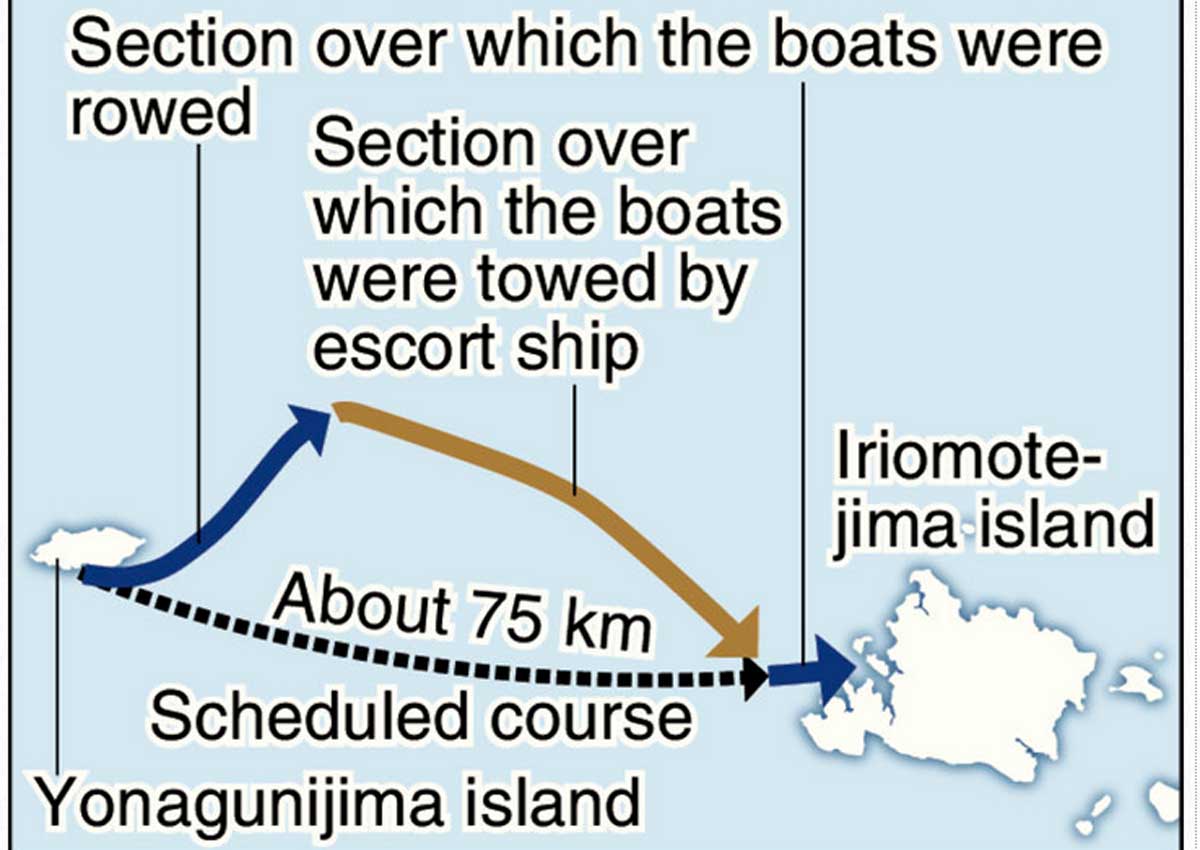In July, a project team led by researchers of the National Museum of Nature and Science took on the challenge of reenacting a sea voyage made 30,000 years ago with boats made of grass fibers. Their aim was to unveil how ancestors of the Japanese moved from Taiwan to the Ryukyu Islands.
However, the boats were unable to pass through strong sea currents and ultimately the experiment failed.
Though the mystery of the voyage was intensified, members of the project team said they will continue the study by making use of their experiences in the failed attempt.
Vessel design, provisions unknown
Nature was much more powerful than the researchers had expected.
The two grass boats, each carrying seven rowers, departed from Yonagunijima island in Okinawa Prefecture in the early morning on July 17 to head for Iriomotejima island in the prefecture, about 75 kilometers east of Yonagunijima island.
The boats were scheduled to sail for 30 hours to reach the destination. However, even though the rowers paddled aggressively, neither of the two boats were able to sail east and instead drifted farther north.
Eight hours after departure, the boats were about 30 kilometers northeast of Yonagunijima island.
Yosuke Kaifu, chief of the museum’s division of human evolution and the representative of the project, decided that changing the course of the boats was impossible and had an escort ship tow them.
“It was a painful decision,” Kaifu said.
The rowers moved to the escort ship and the team gave up on sailing during the night. In total, the team relied on the escort ship for more than half of the sailing distance.
It is highly likely that some of the sailing conditions were different from those the past rowers faced. As there are few clues about how the voyage was made 30,000 years ago, all the researchers can do is guess.
Boats made of wood could likely travel at a higher speed. But no necessary tools to process wood for that purpose have been found in ruins in Okinawa Prefecture, which date back to 20,000 to 30,000 years ago.
For that reason, the researchers chose grass boats. Locally produced plants such as narrow leaf cattail were used to make them.
If sails were attached to the boats, the rowers could harness the power of winds. But the researchers did not elect to do this, choosing instead to paddle by hand.
“There is no evidence that sails were used, even in the Jomon period that dates back to 16,000 years ago,” a researcher said.
However, the researchers did not use traditional materials for the paddles. They used order-made paddles of yellow cedar produced in North America. The wooden materials were created with reference to the paddles used in the Jomon period.
The rowers for this journey were young people living in Yonagunijima and Iriomotejima islands. They had little experience with sailing long distances.
Because the original travellers were able to produce offspring, one of the seven rowers in each boat was a woman. Kaifu said, “We knew the travellers also travelled such a long distance on their first voyage, so we chose inexperienced people.”
It is also unknown what kinds of food and drink the ancestors took for the voyage. The boats carried foods thought to have been available 30,000 years ago, such as dried bananas and nuts, and 10 liters of water for each of the rowers.
The project team aims to search for conditions that will enable the voyage to be successful in the future.
Sailing essential for immigration
In the Ryukyu Islands, human bones were discovered dating back to 20,000 to 30,000 years ago. Analyses on the DNA of human bones on Ishigakijima island suggested that the ancestry of residents at that time stretched back to southern China or Southeast Asia.
The climate of the earth 30,000 years ago was cooling. The sea level is assumed to have been about 60 meters lower than now.
Under such conditions, Taiwan and continental China must have been connected by land, but Taiwan and the Ryukyu Islands would have been separated by sea. Therefore a sea journey would have been necessary to emigrate from Taiwan to the Ryukyu Islands, so the project team will try to reenact this voyage made 30,000 years ago.
The team previously had planned a journey from Taiwan to Yonagunijima island to take place in July next year. But the distance of the journey is longer than the recent attempt – more than 110 kilometers – and the boats must pass through the Kuroshio Current.
On Aug. 27, the project team said next year’s voyage will be postponed for one year.






